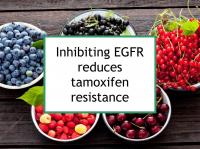A significant fraction of estrogen receptor positive (ER+) tumors treated with tamoxifen eventually develop resistance to the drug, which means that breast cancer cells no longer respond to it. Factors such as exposure to light at night and bisphenol A (BPA) have been reported to contribute to tamoxifen resistance.
Now a new study has reported that inhibition of epidermal growth factor receptor (EGFR) can reduce tamoxifen resistance. The authors also explain the mechanism of action. EGFR has been shown to promote proliferation and migration of tumor cells, thus facilitating the spread of cancer. While the study used the EGFR inhibitor gefitinib (Iressa) to inhibit EGFR, there are also a number of foods that can help reduce the harmful effects of EGFR.
Foods that help inhibit EGFR
The following foods or their major micronutrients have been found to inhibit EGFR, as well as having been shown to reduce the risk of breast cancer in general:
- Arugula
- Blackberries
- Blueberries
- Bok choy
- Boysenberries
- Broccoli
- Brussels sprouts
- Buckwheat
- Cabbage, especially red
- Carrots, purple
- Cauliflower
- Celery
- Cherries
- Collard greens
- Cranberries
Latest research shows how EGFR promotes tamoxifen resistance
The study referenced above was designed to investigate how breast cancer cells become tamoxifen resistant. Previous research has demonstrated that the epithelial‑to-mesenchymal transition (EMT) process has a role in the development of breast cancer drug resistance. EMT is a crucial event in the tumor invasion process. An EMT enables an epithelial cell to undergo a variety of changes that empowers it to assume a mesenchymal cell phenotype, thereby acquiring enhanced migratory capacity and invasiveness, as well as elevated resistance to apoptosis (programmed cell death). However, until now, the central molecules inducing the EMT process during the progression to tamoxifen resistance have not been well described.
In the study, the authors show that breast cancer cells undergo EMT and experience increased cell motility and invasive behavior in the process of becoming tamoxifen resistant. The authors were able to reverse the signs of EMT in tamoxifen‑resistant breast cancer cells (thereby reducing tamoxifen resistance, migration and invasion) through inhibition of snail family transcriptional repressor 1 (Snail) and twist family BHLH transcription factor 1 (Twist). Furthermore, inhibition of EGFR with the EGFR inhibitor gefitinib was shown to reverse the EMT phenotype in tamoxifen‑resistant ER+/PR+ cells through the downregulation of Snail and Twist.
The authors conclude that EGFR might be a promising target for the treatment of tamoxifen‑resistant breast cancer and that gefitinib has the potential to serve as an effective therapy.
Please see our article on diet during tamoxifen treatment and the tamoxifen resistance tag for more information.
